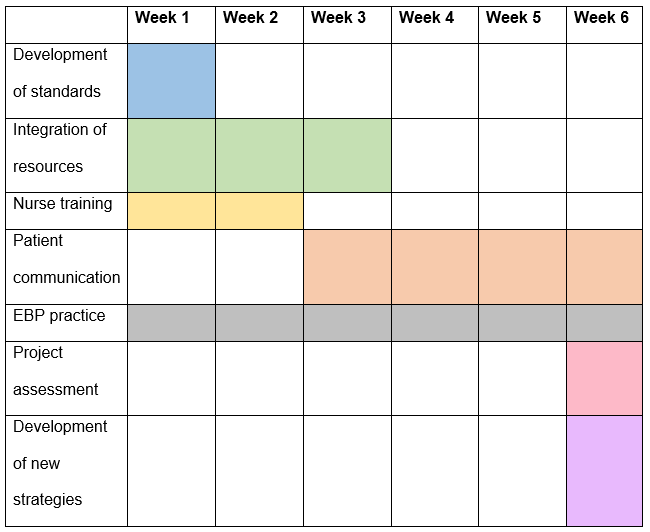Implementation Steps
The first step of the implementation phase of the project will require reconsidering the current standards for managing and preventing HAI in the hospital setting. Nurses will need to be given rigid quality guidelines and clear instructions that will inform their actions and allow reducing the threat of HAI. Nurses must be offered access to the specified guidelines to revisit them and address them whenever there is the necessity to do so. Thus, a gradual positive shift will occur in the specified setting.
In addition, the current sanitary norms should be reviewed to ensure that they meet the set standards and allow reducing the threat of HAI to its logical minimum. For example, the issues associated with HIA surveillance have to be managed based on the latest sanitation standards (McAlearney et al., 2017). The specified task includes establishing a surveillance system that allows responding to the emergent HAI in a timely fashion and reducing the threat to its minimum. In addition, the measures related to the integration of control tools should be taken.
Creating the environment in which nurses will feel inclined toward gaining important knowledge and skills is the next stage of changing the target setting to a new environment that will encourage patient-focused nursing. Thus, building the setting with a positive attitude and the philosophy of collaboration, evidence-based practice, and active patient-nurse communication is critical. The described changes will imply a shift in the set of values that nurses and healthcare staff members apply to their workplace decision-making.
Creating and conducting training sessions will be the next step toward managing the problem of HAI in the clinical setting. Nurses and other staff members will be provided with clear and all-embracive instructions concerning the management of inpatients’ needs and the prevention of HAI in the clinical setting. The problem of HAI development in the ICU and ER setting will be especially important due to the unique environment thereof.
The stage involving the discussion of communication strategies and the promotion of patient education will be the next item on this list. Nurses will also have to play the role of educators in the target clinical setting so that patients could be shielded from the development of HAI completely. Therefore, nurses will have to warn patients about the threat of HAI, as well as the steps that the target population should take in order to avoid the problem in question (Yallew, Kumie, & Yehuala, 2016).
Tools for patient education and the relevant resources will be provided to nurses at the specified stage of project implementation. Evidence-based practice is another logical step in integrating new principles into the healthcare environment (Lucas et al., 2016). Nurses and other staff members will have to implement the deigned strategies for HAI prevention under the supervision of managers.
The final stage of addressing the instances of HAI will require institutionalization of change and introduction of tools for monitoring patients’ well-being after their stay at the hospital is over. The assessment of the effects that the described program will have on the hospital and the patients’ well-being should be seen as the final stage of the project implementation. The outcomes of the assessment will inform the next strategy that the organization will take to handle the threat of HI.
Time Frame
It is expected that the implementation stage of the project should take approximately two months. With the remodeling of instructional guidelines, change in nurses’ behaviors, and rearrangement of the process of care, the preparations for the change will take approximately two weeks. The institutionalization thereof along with the training of the needed qualities and skill swill also take around a month, followed by the analysis of changes and the design of an approach that will, later on, be institutionalized in the target environment.
Thus, the selected time frame is justified by the size and scope of the alterations that will have to take place. In addition, there is the probability of reluctance among staff members to accept the proposed change, which may require an additional week to address. Thus, the total of two months seems to be a legitimate amount of time to introduce changes to the hospital and reduce the probability of HAI in it.

Budget
There are also several budgetary considerations that may have to be taken into account during the implementation of the project. Thus, it will be necessary to fund the learning program aimed at educating nurses about the means of controlling the levels of HA within the hospital setting. In addition, purchasing the resources needed for the training process will imply reconsidering the current financial strategy and shaping the approach toward using the hospital’s financial assets. A total of $200,000 will have to be spent on salaries for nurse educators, whereas approximately $50,000 will be used to buy the necessary equipment and tools, including IT and ICT devices for maintaining communication within the hospital setting.
References
Lukas, S., Hogan, U., Muhirwa, V., Davis, C., Nyiligira, J., Ogbuagu, O., & Wong, R. (2016). Establishment of a hospital-acquired infection surveillance system in a teaching hospital in Rwanda. International Journal of Infection Control, 12(3), 1-9. Web.
McAlearney, A. S., Hefner, J. L., Sieck, C. J., Walker, D. M., Aldrich, A. M., Sova, L. N.,… Buck, J. (2017). Searching for management approaches to reduce HAI transmission (SMART): A study protocol. Implementation Science, 12(1), 82-85. Web.
Yallew, W. W., Kumie, A., & Yehuala, F. M. (2016). Point prevalence of hospital-acquired infections in two teaching hospitals of Amhara region in Ethiopia. Drug, Healthcare and Patient Safety, 8, 71-76. Web.